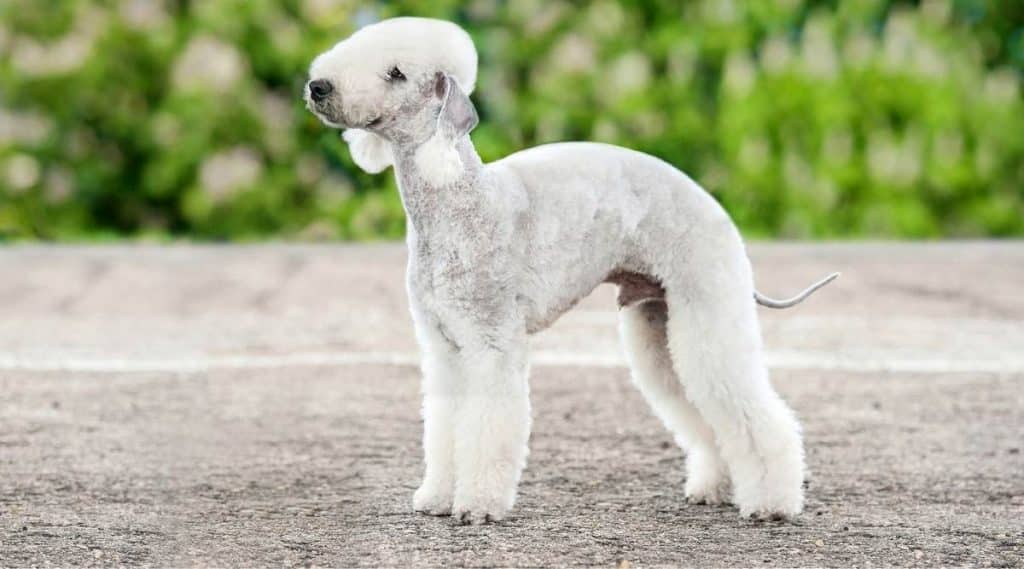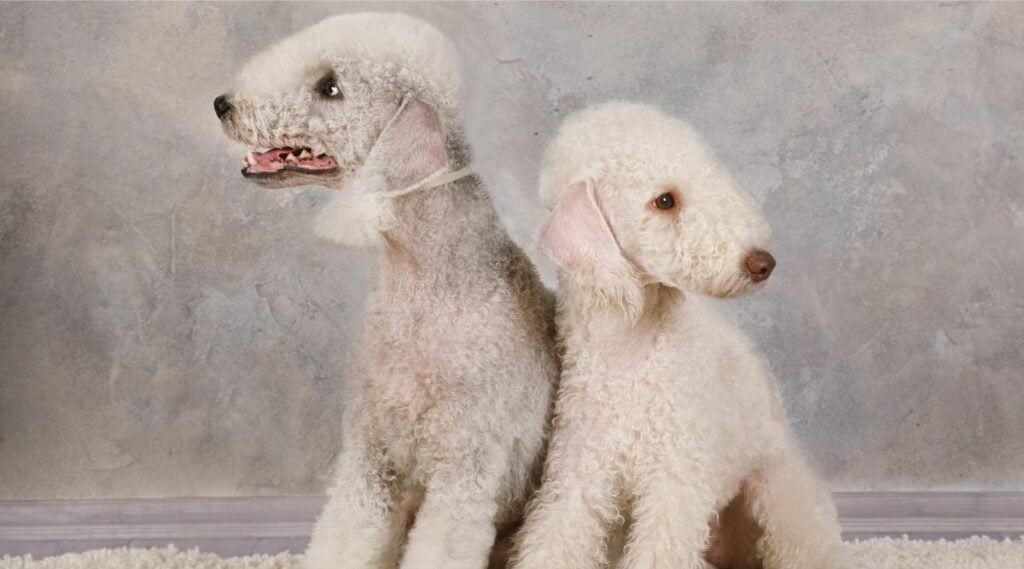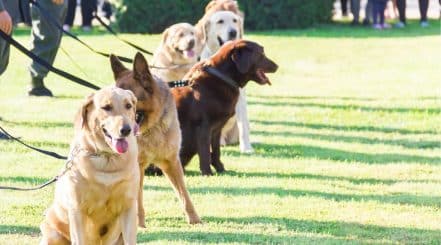If you’ve ever mistakenly thought someone had a lamb on a leash, only to discover the lamb was not a lamb at all, you may have met a Bedlington Terrier. This unique breed was once the rat-killing companion of coal miners. In modern times, the Bedlington has become an active and virtually shed-free family friend.
Bedlingtons are versatile dogs. While quite effective in the field as hunting dogs, they are more often family companions. Their athleticism and speed make them worthy competitors in agility and coursing ability trials. On the straight, the Bedlington shifts into a high-speed gait known as the “rotary gallop,” typically associated with sighthounds like the Greyhound or Whippet.
Bedlington Terriers today are relatively rare. Thanks to the availability of genetic testing, parent dogs can be screened for hereditary conditions that caused the breed problems through the mid to late twentieth century. These charming, medium-sized dogs excel in canine sports, as vermin control on large and small farms, and as cuddlers extraordinaire at home with family.
Breed History

The Bedlington Terrier’s history is rooted in the vocation of most early British terrier-type dogs. Early terriers were bred with other breeds to rid the area of vermin to create a dog that could specialize in eliminating specific pests. Otterhounds may have been bred in for strength, Whippets for speed, and Poodles for their protective curly coat.
Records do exist back to the eighteenth century suggesting the breed was created to both go to ground, which means to chase an animal down into its burrow, and to run down prey on foot. Originating near the shire of Bedlington in Northumberland, Aynsley’s Piper was the first dog officially labeled a Bedlington. Legend has it that Piper was hunting at eight months and could take the fiercest of badgers and otters even in his old age.
These fierce little dogs weren’t only killing coalmine rats and other varmints and fighting in pits but also living indoors and becoming home companions. The Romani even used the breed as a guard dog to alert them while poaching, and the Bedlington earned the nickname “Gypsy Dog.” Unfortunately, the number of Bedlington Terriers has declined over the past few decades. Partially due to a lethal genetic predisposition for copper toxicosis, the number of Bedlingtons dwindled through the nineteen seventies and eighties.
Temperament

The Bedlington may be built like a sighthound, but his courageousness is a pure terrier. Playful and lively, Bedlingtons have a great time wherever they go. They have a particular fondness for children but love people in general. Their inquisitive and perceptive nature makes them excellent companions, ready for anything from a job catching rats to a cuddle on the couch.
The temperament of the Bedlington has two sides. Generally, Bedlingtons are quiet companions like other sporting dogs. Even when they’re in pursuit of a varmint, they tend to do so quietly. When confronted or riled, however, their terrier spirit snaps to attention, and they’re ready to fight the good fight. Bedlington Terriers are eager to please and even make excellent watchdogs.
Size & Appearance

Standing between fifteen and seventeen and a half inches at the shoulder, the Bedlington is the perfect size for an active family in any setting. They generally weigh around twenty pounds.
While the most noticeable feature of the Bedlington is his unique coat, he also has unusual body characteristics for a terrier. Lithe and light on his feet, the Bedlington is built for speed and endurance. His arched back and tucked loins reflect the sighthound in his lineage. Graced with a topknot at its crown, his slender face tapers as it approaches his nose. Bright almond eyes with no tendency to tear express his character.
Bedlington Terriers have a surprisingly flexible frame while being deep-chested and muscular. His gracefully arched back flows into a low set tail best described as shaped like a scimitar, a single-edge sword with a curved, convex blade. This unique, sighthound-like build provides him a lilting, springy step at the slower gaits. He should track straight and true when viewed in motion from front and behind.
Coats & Colors

With the appearance of a lamb, the Bedlington’s coat is described in the breed standard as “crisp” to the touch. Woolly but not wiry, the Bedlington’s coat is a mixture of hard and soft hair that stands well off the body, but in a show, the trim must not be more than one inch long.
Bedlington coat colors are as soft as their woolly curls themselves. Their coat may be blue, blue and tan, liver, liver and tan, sandy, or sandy and tan. In bi-color dogs, the tan markings are generally on the lower parts of the dog. The distinctive woolly topknots on their heads should be lighter than the adult’s body color.
Living Conditions

Because of their energy levels, Bedlingtons thrive in an active family. They crave activity and love the chase. Like many varmint dogs, Bedlingtons will dig holes in the yard if they believe there’s something to chase. Because they are such good diggers, be sure your fence is secure to the ground and watch for signs your dog has begun a tunnel to freedom.
A Bedlington is not out of the question if you don’t have a fenced yard, but exercise must be a priority. To keep him fit and mentally satisfied, a jog or long walk once or twice daily is a great start. He’ll appreciate a good chase at the dog park but keep an eye on any canine aggression aimed in his direction because he’s liable to retaliate.
Training

Although the Bedlington has the independent spirit for which terriers are known and loved, he’s also eager to please. Keep his sessions short and positive, and recognize that harsh treatment will lead to a counterproductive battle of wills.
Health

Copper Toxicosis
Bedlington Terriers are prone to inheriting a metabolic disorder that can lead to liver failure when copper levels are higher than normal. Copper-associated hepatopathy was first described in Bedlingtons at the end of the 1970s. Genetically susceptible Bedlingtons accumulate copper concentrations toxic to the liver and show symptoms by the time they are two to four years of age. They develop chronic hepatitis and cirrhosis due to this inherited metabolic defect.
Liver toxicity symptoms include decreased appetite, weight loss, diarrhea, or vomiting. Severely affected dogs may show jaundice and ascites. The canine toxicosis locus in Bedlington Terriers has potentially been mapped to a mutated gene. In Bedlingtons over a year old, copper progressively accumulates in the liver through the dog’s mature years. While affected dogs may be asymptomatic, they must be treated with a copper chelator when they begin to show symptoms. Most dogs will live a normal life when diagnosed early and adequately treated.
Ear Problems
Because Bedlington Terriers have a “dropped ear,” or one that folds close to the head, they are prone to ear infections. Like many other “non-shedding” breeds, they grow hair in their ears. This hair, combined with the position of the ear flap, limits airflow and light inside the ear, allowing the overgrowth of various organisms. If your dog is shaking his head and has gunk or a foul odor in his ears, consult your veterinarian. Over-the-counter ear-cleaning solutions and drying powders can help clean and dry the ear canal.
Hypothyroidism
Hypothyroidism is when a dog does not produce sufficient thyroid hormone for his body to function as it should. Symptoms of hypothyroidism in dogs are similar to those in humans, including lethargy, hair loss, changes in behavior, and obesity. Luckily, his imbalance can be remedied by prescription thyroid supplementation. See your veterinarian to have his levels tested.
Joint Dysplasia
Bedlington Terriers can suffer from hip and elbow dysplasia, painful conditions where the joint ball doesn’t properly fit into the socket. The condition stems from a combination of genetics and controllable factors like feeding for rapid growth. Feeding your puppy for steady but slower growth may help avoid this condition. Any potential breeding dog should have an Orthopedic Foundation for Animals (OFA) or PennHIP Evaluation, and buyers should seek puppies from parents with good evaluation results.
Total Retinal Dysplasia
Retinal dysplasia is a disorder that is hereditary in Bedlingtons. It happens when embryonic differentiation is faulty and abnormal retinal folds are created in the eye. Lesions may appear, and eventually, retinal detachment occurs. Severe forms of retinal dysplasia with retinal detachment and blindness occur in Bedlingtons. Your veterinarian can diagnose this disorder through one or a series of eye exams.
Von Willebrand’s Disease
A clotting disorder that occurs from insufficient ‘Von Willebrand’ protein, this disease could put your friend at risk of dangerous bleeding. Ask your vet if they recommend performing the DNA-based vWD test from an approved lab to check for this disorder. The results will be registered with the OFA.
Nutrition

Bedlingtons need approximately a cup to a cup and a half of food per day, and it is always best to break the total amount into two meals per day if possible. Look for age-appropriate dog food that promotes modest growth rates. A high-quality kibble including meat protein, fiber, healthy carbs, omega-3 fatty acids, vitamins, and minerals will meet his nutritional needs.
Grooming

To prepare for shows, he is clipped instead of stripped, and for everyday grooming, a pin brush works effectively to rid his curls of tangles. Bedlingtons need special attention paid to their ears, which tend to trap moisture and dirt and can breed infection. Ear powders help dry the ear and allow a groomer to grip the hairs for swifter and more efficient removal.
Breeders & Puppy Costs

The breed’s numbers have yet to grow dramatically, although modern technology offers better genetic testing than ever before. Because Bedlingtons are challenging to find, expect to pay at least $1,800 and potentially up to $4,000 or more for your new best friend.
Rescues & Shelters
Although Bedlingtons are rare, one may find himself in an unsuitable situation and end up in rescue. Visiting a local animal shelter is a great way to meet the adoptable dogs near you. If they don’t have any Bedlington Terriers available, they might be able to check nearby shelters for you. There is a well-established Bedlington rescue organization on the internet, and there will likely be one in your state or a state nearby.
As Family Pets
Overall, Bedlington Terriers are:
- Nimble and quick.
- Quiet, even when hunting.
- Suitable for varmint control.
- Candidates for genetic screening due to copper toxicity.
- Healthiest with about an hour total of daily exercise.
- Happy to be a lapdog from time to time.
- Low shedding.
- Great exercise companions.
Final Thoughts
If you’d like a companion that will intrigue and charm everyone, consider the Bedlington Terrier. As cuddly as a lamb but with the courage of a lion, the Bedlington excels in the field as a hunting dog, in the stable as a ratter, and in the home as a beloved companion. Although finding a Bedlington Terrier in your area may be a challenge, having a member of this increasingly rare breed in your family is well worth the effort.





